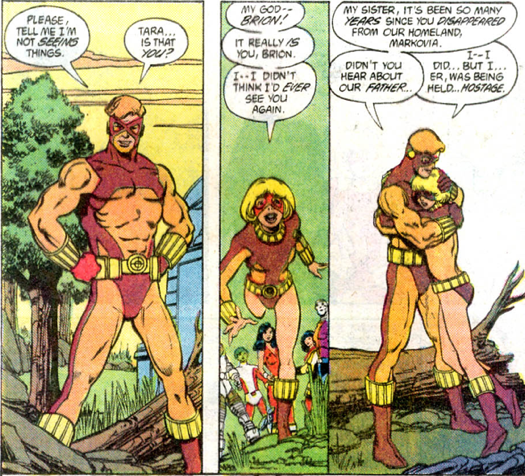
Tara Markov was the illegitimate daughter of the king of Markovia. Like her half-brother Brion, the legitimate prince of Marvokia, she was experimented on by a doctor named Helga Jace, who gave both children the power to manipulate earth and rock. Brion became the superhero Geo-Force, while Tara was sent to America to avoid a scandal. There she adopted the name Terra and started using her powers to steal. When the New Teen Titans apprehended her, she explained that she’d been kidnapped by terrorists, who were forcing her to steal for them. The Titans took down the terrorists and offered Terra membership.
Unbeknownst to the Titans, though, the whole thing was a set-up, and Terra was a spy, employed by their enemy Deathstroke the Terminator to join the team and ferret out their secrets. While the Titans saw her as a scared and defensive young girl (and Beast Boy found himself smitten with her), she was in reality a ruthless sociopath who was disgusted by the Titans’ do-gooderness and gleefully anticipated their deaths. Even her employer (and lover, because creepy) Deathstroke was alarmed by her power and heartlessness.
Terra helped Deathstroke capture the Titans, but before the prisoners could be killed, Deathstroke was possessed by his heroic son Jericho, who released the Titans. Furious at what she perceived as Deathstroke’s betrayal, Terra went completely insane and pulled the entire complex down on herself while trying to kill…well, basically everyone else. The Titans gave her a heroes’ funeral and kept her betrayal a secret in an attempt to protect her brother, but it has since become common knowledge, at least in the superhero community.
So What’s So Great About Her?
Since the original Terra plotline, there have been several other takes on the character. A heroic Tara Markov doppelganger showed up claiming to be from the future and displaying the same powers as the original Terra; though it’s not clear whether she is really the original Terra somehow brought back to life or not, she’s certainly allied with the side of good. The most recent character to take on the Terra mantle (that’s a little geology joke for you), Atlee, is also unshakably good at her core (zing!). And the animated version of Terra in the 2003 Teen Titans show is what readers expected the comic book character to be: a troubled but essentially decent girl who is led astray by Slade/Deathstroke.
But the original Terra doesn’t bother with any of that. She was a shock when she was introduced: a somewhat rabbit-faced little blonde kid, cute as a button, and determined to slaughter the Titans without a hint of remorse. She never betrays any compassion or affection for her teammates, and goes to her grave absolutely crazy with hate. Even knowing how her story ends, reading The Judas Contract today is surprising, with its uncompromising depiction of her sheer maliciousness.
Even beyond the context of her story and the power of the betrayal, Terra’s a fantastic character to read. For starters, she’s a powerhouse, an elemental force who gives the far more experienced Titans and Deathstroke a run for their money. She’s not just a strong fighter, she’s a cunning fighter who learns fast and is an effective member of the team before her true nature is revealed. She’s also smart enough to live with the Titans for months and still manage to hide the truth. And to be perfectly honest, there’s something refreshing about her foul-mouthed disregard for the Titans. Even though the Titans are a likable bunch, it’s hard not to be delighted when Terra mocks their sanctimoniousness and melodramatic romantic entanglements. Sure, she’s evil, but she’s such a fun evil.
Terra had a very brief lifespan, all things considered only about 20 issues. But she’s an enjoyable character and a memorable villain, and her actions continue to have ramifications for the Titans today. Not a bad legacy.
Notable Appearances:
New Teen Titans v1 #26-40
Tales of the Teen Titans 41-44, Annual #3
…Or you can just pick up the trades Terra Incognito and The Judas Contract.